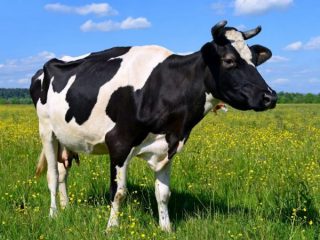Content
The physiological development, milk and meat productivity of cattle directly depend on what the animal eats. The diet must be balanced, clearly meet the needs of the individual’s body at a certain stage of its life, and also correspond to its breed. For example, feeding beef cows will differ significantly from the diet of dairy cows.
How to deal with the variety of feeding solutions? To make the task easier, you can roughly divide animal feed into classes.
Main types
These are the classes of animal feed that make up the bulk of the diet - up to 80-90%. But if it is necessary to increase the productivity of the herd, strengthen the immune system, and obtain healthy offspring, then it will be very difficult to do without premixes and concentrates in the diet.
Roughage
They are good suppliers of plant fiber, without which the body of cattle will not be able to function normally. These include branch feed, hay, straw and haylage.When making hay, it is advisable to use raw materials from various grasses; cereals (timothy grass, meadow fescue, bluegrass, creeping wheatgrass, meadow foxtail, etc.) and legumes (sainfoin, clover, alfalfa) are considered especially valuable. Haylage can be prepared from annual and perennial plants, and branches of linden, birch and maple are excellent as branch feed.
Juicy feed
This is another important class of feed for animals, with which they must be provided in the required quantities. This is about:
- root and tuber crops, i.e. carrots, sugar beets, pumpkin, potatoes. They contain a lot of dry matter, protein, fiber, sugar and water;
- regular and combined silos. They are a canned juicy mass that may contain potato tops, root vegetables, tubers, edible herbs, etc.
Green feed
This is a feeding method available in the warm season, provided the herd is kept on pasture. Forbs, legumes and sedges are easily digested by livestock. They contain vitamins E, K and B, lipids, carbohydrates and proteins.
Additional views
The main classes of animal feed are supplemented by products that are introduced into the diet in limited quantities. For example, transferring livestock completely to feeding with compound feed is quite rare, since it usually acts as a supplement to the main diet.
Combined feed
It is a mixture of plant components. Sometimes its composition includes elements of animal origin and vitamin and mineral supplements.For example, the compound feed for calves from Mustang Feeding Technologies (these are Calvomuesli, Calvofit Lux and Calvofit) includes grains, soybean meal, flaxseed, a vitamin-mineral complex, a bactericidal component, etc. Such a combined mixture promotes early rumen formation, strengthens immunity, ensures high growth rates of calves and increases their safety.
Concentrates
This is an excellent additive to roughage and succulent feed, as well as to compound feed. The input rate is approximately 10-30% in the combined feed. Concentrates from Mustang Feeding Technologies consist of a premix and a protein part, and contribute to:
- eliminating the lack of crude protein;
- increasing milk and meat productivity;
- preventing lameness;
- reducing the risk of acidosis;
- optimization of rumen fermentation, etc.
Premixes
This is the name for a mixture of biologically active substances for which flour is used as a filler. They are in demand regardless of what classes of animal feed are primarily used on the farm. Their peculiarity lies in their economical consumption: the rate of input of premixes from Mustang Feeding Technologies does not exceed 2%! The company produces separate lines for dry and lactating cows, which allows them to fully satisfy their needs for micro- and macroelements, vitamins and amino acids at every stage of life.
Energy supplements
The products have a narrowly targeted effect. For example, Lactoneo prevents ketosis, acidosis and lameness, and fights fatty liver syndrome. The goal of “Kaustart” is to fill the lack of energy, normalize liver function and reduce the amount of ketone bodies.
As practice shows, no matter what class of animal feed you choose, having only the main types of feed solutions in the diet will not be enough. Compound feeds, premixes, concentrates and high-quality energy supplements will help increase the efficiency and profitability of farming with minimal investment and effort!














